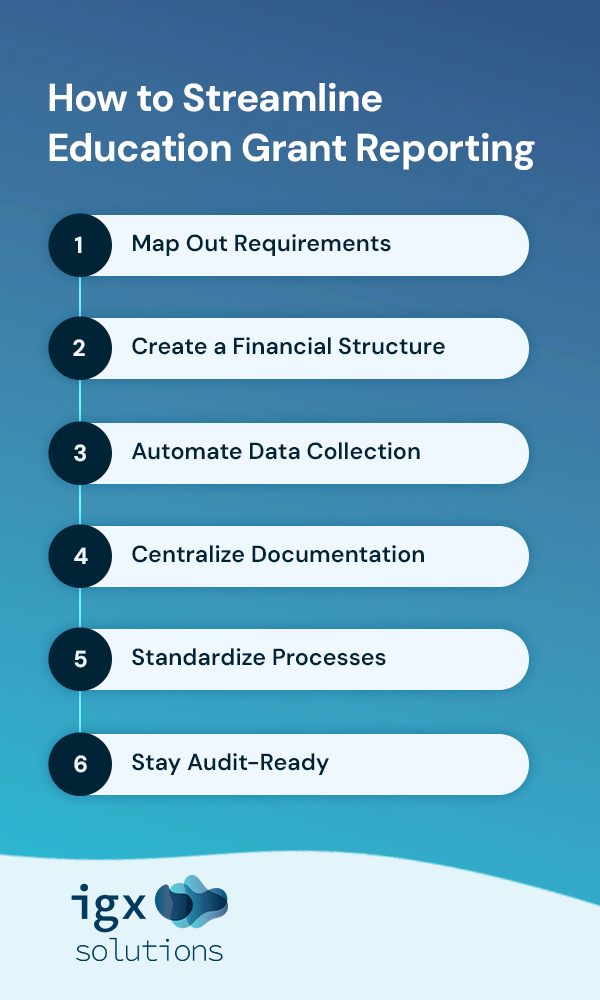
Table of contents:
Educational institutions rely on grants, but maintaining funding requires strict grant reporting. Programs like Title I and IDEA require schools to track thousands of details. The more funding streams you manage, the more complex your reporting. Streamlined processes are essential for compliance and efficiency.
Education grants require tracking enormous amounts of data. When you add up all the fiscal and personnel data and combine it with measuring outcomes and managing multiple grants, it becomes overwhelming quickly. Throw in reporting and data requirements, and there are dozens of hoops to jump through. Universities and schools are dealing with:
When all of these challenges come together, the reporting process halts. Spreadsheets bounce between departments, while information discrepancies turn into time-consuming reviews. The education grant reporting cycle slows as team members chase down missing documentation. Each grant cycle becomes a stressful, slow process.
Beyond wasted time, poor reporting creates compliance risks. Federal programs require accurate compliance to maintain funding. Reporting errors can trigger audits or reimbursement delays, and disconnected systems let expenses go untagged and keep teams from seeing essential updates. Agencies unable to show proper spending lose grant providers’ trust.
Program directors need accurate data to show how grants are supporting their intended mission. This is difficult if data is scattered across siloed systems. Staff have to hunt for data and get everything into one place without missing information. Demonstrating a grant’s impact is harder without reliable, consolidated reporting. Federal, state and community grant providers want to see that their dollars are being put to good use.
Part of providing education means understanding where grant funds are needed most. Extra time spent collecting and correcting data reduces time for analysis. Teams might miss new community opportunities while searching for documents. Organizations neglect strategic planning and miss out on furthering their educational goals.
Poor reporting can even leave money on the table. Grants usually have strict timelines. Organizations must show spending, measurable outcomes and matching funds to qualify for future grants. Incomplete or late reports can cost districts future funding — missed submissions lead to fewer resources for programs and staffing.

Streamlining grant reporting requires planning and integrated systems. Because funding involves every department, data needs a structured, interconnected framework. Accuracy and consistency make compliance a routine that works cycle after cycle. Follow these tips on grant reporting for educational facilities:
Know your reporting requirements before submission. Start by mapping out how each grant works. What must be tracked, how is it reported and when is it due? A clear view of requirements helps identify data and assign responsibilities.
Get finance teams, program managers and compliance officers to coordinate. Identify data fields, performance indicators and timelines. From there, staff can build templates and standards early in the reporting cycle. Everyone will understand their roles and documentation standards before the data pile-up becomes confusing.
Reporting is all about data. That means educational institutions need to organize their financial data early. Build your chart of accounts around grants, funding sources and cost categories. Make sure every expense and payroll entry is clearly connected back to its funding source. Consistent traceability and order prevent staff from having to sort costs at the end of the reporting period.
Clear, planned financial structures also keep you audit-ready and prepared for the future. Departments can see how funds are being used and where. This insight makes it easy to catch problems before they lead to underspending or overages.
Relying on manual data movement can lead to falling behind. One delay quickly falls into a slow, disorganized data flow. Automation improves efficiency by connecting your critical information systems. Instead of manually transferring data between departments, automated solutions pull data continuously. HR, payroll, student information and metrics all stay current without adding extra staff work.
Automation also protects data integrity. Built-in system validations flag missing documentation or entry errors. Catch out-of-scope costs before submitting reports and keep your grant reporting correct and compliant.
Data organization is a major challenge for any organization, and education is no different. Managing attendance data, vendor invoices, progress reports, staff hours and assessment results is often scattered around emails and departments. Tracking down information for deadlines slows down staff and holds up reporting. Centralizing that information transforms your grant management efficiency.
A shared space lets teams handle all tracking and submissions for each grant. With all the necessary information, it becomes easier to show how funds connect to results. Staff can contribute to updates and keep everyone on the same page. Plus, systems with dashboards simplify data reading and ensure everyone knows when the next deadline is.
Centralization also improves transparency. Clear, compiled records and updated metrics make communicating with boards simple. Just send them the centralized records and never get mixed up with spreadsheets and outdated attachments.
The next step to more efficient reporting is routine. If each department uses its own processes, it’s harder to collaborate or fix inconsistencies. Establish a repeatable close and review process to stop confusion from delaying reporting.
Set up internal schedules to keep everyone on track. Staff need time to review and revise submissions before validating and submitting them. Create defined review steps and regular checkpoints to catch errors. This way, teams regularly check and verify data without everyone rushing at the end of the cycle.
Combine standardization and schedules with role-based workflows. Clear roles let everyone know exactly what actions are required and what information they handle. Everyone takes care of their tasks, preventing actions from getting skipped over. You’ll create an organized, predictable reporting cycle.
Finally, you need to stay ready for audits. Every education grant eventually undergoes reviews. Internal compliance checks or state-level reviews keep the grant process honest and effective. Funders expect documentation that explains how you spent their dollars and what they accomplished.
A structured reporting framework and management software help institutions ensure audit readiness. Your organization can generate accurate reports at any time. Export financial data into the proper formats, pull performance summaries and maintain version control. The right software and processes mean reviewers can easily trace transactions to the source.
Organized, fast reports also improve efficiency. Staff can pull the documentation and send it off for review immediately. That’s less time assembling reports and more time focusing on building effective grant programs.
Schools and agencies need to track the right data to maintain successful reporting. Financials, outcomes and artifacts are essential for building out your reporting strategy. Focus on these areas to protect your grant status and improve efficiency:
Grants often involve government and foundation funds. These programs require institutions to meet specific standards to ensure funding is used as intended. Grant reporting begins with how your organization allocates and spends these funds. Your agency should track:

Grant awarders want to see results from their investment. Schools should track program data to remain compliant. Information like participation levels, resource access and outcome achievements reveal how funding has helped the community. The goal is for outcome data to show that funds produce a measurable impact. Funding outcome data is critical for meeting grant requirements and planning future programs.
Supporting documentation is how you prove report accuracy. Your institution needs a transparent audit trail made from:
Linking this information to related transactions simplifies expenditure tracking. Look for systems with automated timestamps and version control to support accountability. With detailed documentation, you can prepare for audits and prove grant compliance.
Spreadsheets and emails slow down progress. Educational institutions need digital systems built to manage complex funding programs. The right technology provides structure and automation, making overseeing every stage of the grant life cycle easier.

Digital, automated tools eliminate hours of re-entry. Automated routing lets approvals move smoothly between departments. Features like real-time validation catch missing data and unallowable costs before submission. Software even generates audit trails automatically so staff can follow changes without paper searches. Automation makes reporting a continuous, accurate process instead of an end-of-year scramble.
At the end of the cycle, financial and program data should match. Use grant software with configurable dashboards and reporting forms to consolidate reporting. Staff can see budgets and outcomes in one area, while built-in templates improve documentation consistency. They no longer have to juggle confusing reports, and leaders can instantly see grant progress before critical deadlines.
Disconnected systems let information slip through the cracks. Someone in a siloed department might have data you need to keep reporting accurately. Grant management platforms solve this issue by integrating with your existing tools. Transactions move through systems automatically, eliminating manual uploads. With integrated systems, teams reduce manual entry errors and save time going between systems.
An effective grant management platform will have fast implementation times. Agencies can use these platforms to get their new system up and running in weeks. Just partner with a system tailored to your structure and grant needs. Educational staff can use intuitive dashboards, secure role-based access and continuous validation for more accurate, efficient reporting.
Here are some answers to commonly asked education grant reporting questions:
The five Rs are research, relevance, relationships, results and review. These five principles help you develop stronger grant proposals. Use research to find funding opportunities, relevance to align projects with funders, relationships to improve collaboration, results to show measurable outcomes, and review to keep projects compliant before submission.
Use a centralized digital system to organize grant files. Sort files into folders labeled by grant and reporting period, and keep your naming conventions consistent. Make sure to link supporting documents like invoices directly to each grant record. With grant management software, you can automate version control and keep everything ready for audits.
Key performance indicators (KPIs) measure financial and program data. Every program has goals and financials to track — KPIs let you see if you’ve hit those goals. Common KPIs include drawdown rate, spending accuracy, milestone completion, participant outcomes and progress toward objectives.
Track grants with detailed documentation and automated tools. A centralized tracking system makes recording data easy, while automated tools reduce errors and ensure information reaches the right places.
Institutions measure grant success through outcomes and efficiency. Were your goals achieved? Were funds used responsibly? Did the project generate lasting outcomes for students or the community? Performance data and program feedback let teams evaluate a grant’s success.
Leave slow paperwork and disconnected information behind. Efficient education funding management makes your programs more effective. With IntelliGrants IGX, your institution can manage the entire grant life cycle from one secure, user-friendly platform. Our grant reporting tools for education include automation to reduce manual work, while real-time dashboards show spending and outcome data. Plus, built-in compliance checks keep your team audit-ready year-round.
If your team is ready to move beyond spreadsheets and streamline education grant reporting, it’s time to see what IntelliGrants IGX can do. Schedule a demo today and discover how a smarter, more efficient reporting process can help improve education outcomes.
